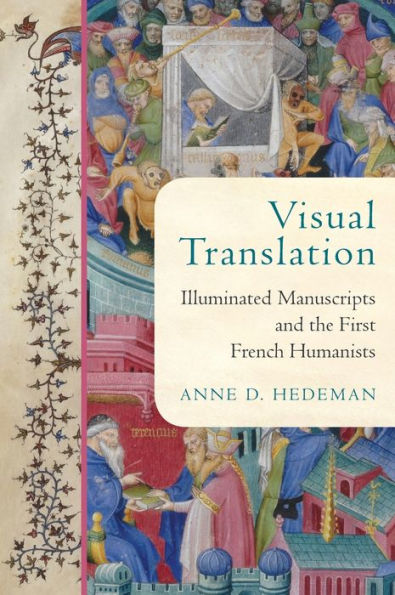
Visual Translation: Illuminated Manuscripts and the First French Humanists
394
Visual Translation: Illuminated Manuscripts and the First French Humanists
394Hardcover
-
PICK UP IN STORECheck Availability at Nearby Stores
Available within 2 business hours
Related collections and offers
Overview
While the prominence and quality of illustrations in French manuscripts have attracted attention, their images have rarely been studied systematically as components of humanist translation. Anne D. Hedeman fills this gap by studying the humanist book production closely supervised by Laurent de Premierfait and Jean Lebègue for courtly Parisian audiences in the first half of the fifteenth century.
Hedeman explores how visual translation works in a series of unusually densely illuminated manuscripts associated with Laurent and Lebègue circa 1404–54. These manuscripts cover both Latin texts, such as Statius’s Thebiad and Achilleid, Terence’s Comedies, and Sallust’s Conspiracy of Cataline and Jurguthine War, and French translations of Cicero’s De senectute, Boccaccio’s De casibus virorum illustrium and Decameron, and Bruni’s De bello Punico primo. Illuminations constitute a significant part of these manuscripts’ textual apparatus, which helped shape access to and interpretation of the texts for a French audience. Hedeman considers them as a group and reveals Laurent’s and Lebègue’s growing understanding of visual rhetoric and its ability to visually translate texts originating in a culture removed in time or geography for medieval readers who sought to understand them. The book discusses what happens when the visual cycles so carefully devised in collaboration with libraries and artists by Laurent and Lebègue escaped their control in a process of normalization. With over 180 color images, this major reference book will appeal to students and scholars of French, comparative literature, art history, history of the book, and translation studies.

Product Details
| ISBN-13: | 9780268202279 |
|---|---|
| Publisher: | University of Notre Dame Press |
| Publication date: | 04/15/2022 |
| Series: | Conway Lectures in Medieval Studies |
| Pages: | 394 |
| Product dimensions: | 7.00(w) x 10.00(h) x 1.19(d) |
About the Author
Read an Excerpt
Because few illuminators read Latin, artists must have received directions, possibly from Laurent, about the subjects they should paint. In constructing these pictures, they adapted common workshop models that they had accumulated, which gave the antique stories a contemporary resonance. For instance, one of the two miniatures painted by the Virgil Master (fig. 2.3) employs models also used in a contemporary manuscript given to John of Berry ca. 1405, Jean Creton’s Livre de la prinse et mort du roy Richart d’Angleterre [Book of the Capture and Death of King Richard II] (BL Harley Ms. 1319). A comparison of the positioning, scale, and rendering of horse and rider in scenes from these manuscripts or of the treatment of architecture within them (compare figure 2.3 to figs. 2.4 and 2.5) reveals the use of shared models, but also differing levels of complexity of space and treatment of landscape. The Virgil Master Illuminator may have simplified his treatment of space in the illuminations of the Thebaid to harmonize with images painted by other artists in the manuscript.
While individual artists drew on their stock of models to realize scenes, someone like Laurent de Premierfait, who wrote the summaries and who knew Roman culture and the Latin text of Statius well, must have suggested the subjects and iconography of individual illuminations, which the artists then interpreted and visualized by drawing on fifteenth-century artistic conventions, as happened in the Virgil Master Illuminators’ representation of Mercury in the illustrations for both Plautus and Statius.
Sometimes artists drew on traditions of visual representation that were distinct from Statius to illustrate this manuscript. Both the Virgil Master Illuminator and an artist working in the style of the Master of the Ovide moralisée (fols. 104-105) gave the god Mercury special emphasis that went beyond the details of his appearance that Statius provided when describing Mercury’s reaction to Jupiter when he admonished Mercury to take a message to Laius (Thebaid 1.303-308): “Atlas’ grandson obeys his sire’s words and hastily thereupon binds the winged sandals unto his ankles and with his wide hat covers his locks and tempers the stars. Then he thrust the wand into his right hand…” The artists’ visual representations differ. In one of two illuminations that the Virgil Master contributed to the manuscript, he painted a scene (fig. 2.6) showing Juno kneeling before Jupiter at the council of the gods, to mark the beginning of the speech in which she begged Jupiter to change his mind about stirring up war between Argos and Thebes (Thebaid 1.248). Juno and Jupiter appear as a king and queen, and the other gods, with the exception of Mercury, wear exotic eastern dress and turbans. Mercury alone is distinctive among these lesser gods, probably because Juno, Jupiter, Pluto, and he were the only ones mentioned, but not described, in Laurent’s summary. In the illumination Mercury has an animalistic face, green wings sprouting by his ears, human hands, and scale-like fur on his legs, feet, and head, and he holds a staff. This formulation recalls that which the Virgil Master Illuminator used to illustrate Mercury in the contemporary frontispiece to Plautus’s Comedies (fig. 1.4) in which Mercury also has fur resembling scales on his hands and floppy canine ears.
Table of Contents
List of FiguresEditorial Principles and Abbreviations
Acknowledgements
1. Introduction
Part 1: Illustrating the Past in Latin Texts
2. Laurent de Premierfait’s Involvement with Statius’s Thebaid and Achilleid and Terence’s Comedies3. Jean Lebègue and Sallust’s Conspiracy of Catiline and Jugurthine WarPart 2: Illumination in French Translations
4. Illuminating French Translations by Laurent de Premierfait
Part 3: The Cycles Escape
5. Normalization
Appendices
Bibliography
Index
